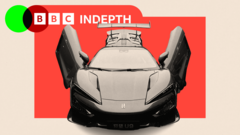
The Electric Vehicle Revolution: China's Ascendancy and the Future for the UK and Europe
The global automotive industry is undergoing a seismic shift, propelled by the relentless march of electric vehicles (EVs). This transition presents both unprecedented opportunities and significant challenges for established automotive markets like the United Kingdom and Europe. At the heart of this transformation lies China, rapidly emerging as the dominant force in EV production, innovation, and market share. This article explores the implications of China's rise for the UK and Europe, examining the competitive landscape, national security concerns, and potential pathways for navigating this evolving landscape.
China's Dominance in the EV Ecosystem
China's ascent in the EV sector is multifaceted, built upon substantial government investment, a robust domestic market, and a strategic focus on key components of the EV supply chain.
- Manufacturing Prowess: China has invested heavily in battery production, securing access to critical raw materials like lithium and cobalt. This vertical integration provides a significant cost advantage over competitors.
- Domestic Demand: The sheer size of the Chinese market provides a fertile ground for EV adoption. Government incentives and policies further accelerate this trend.
- Technological Innovation: Chinese EV manufacturers are rapidly innovating, developing competitive technologies in battery technology, autonomous driving, and connected car services.
The UK and Europe: Caught in the Crosshairs?
The rapid growth of the Chinese EV industry presents a complex challenge for the UK and Europe. While competition can drive innovation and lower prices for consumers, it also raises concerns about market share erosion, job losses, and dependence on foreign suppliers.
Competitive Pressures
European automakers face intense competition from Chinese brands offering technologically advanced EVs at competitive price points. This pressure forces established players to accelerate their own EV transitions and invest heavily in research and development. However, the pace of change may not be sufficient to maintain market leadership.
Supply Chain Vulnerabilities
The dominance of Chinese companies in battery production raises concerns about supply chain vulnerabilities. Dependence on a single source for critical components can create risks related to geopolitical instability, trade disputes, and potential disruptions to manufacturing.
Job Displacement
The shift to EVs requires significant reskilling and workforce transformation. Traditional automotive jobs may be displaced by new roles in software development, battery technology, and charging infrastructure. Addressing this transition effectively is crucial to mitigating social and economic disruption.
National Security Considerations
The increasing integration of EVs into critical infrastructure raises legitimate national security concerns. Connected car technologies generate vast amounts of data, which could be vulnerable to cybersecurity threats or misuse by foreign governments.
- Data Privacy: Ensuring the privacy and security of vehicle data is paramount. Robust data protection regulations and cybersecurity protocols are essential.
- Cybersecurity Risks: EVs are vulnerable to hacking and cyberattacks. Protecting vehicle systems from malicious actors is crucial to ensuring safety and security.
- Supply Chain Security: Diversifying supply chains and reducing reliance on single suppliers can mitigate risks related to geopolitical instability and potential disruptions.
Navigating the Future: Strategies for the UK and Europe
The UK and Europe must adopt a proactive and strategic approach to navigate the evolving EV landscape. This requires a combination of industrial policy, regulatory reform, and international collaboration.
Strategic Investments
Governments should invest in research and development, supporting the development of domestic battery manufacturing capabilities and promoting innovation in related technologies. This includes supporting education programs focused on the skills needed in the new automotive ecosystem.
Regulatory Frameworks
Harmonized regulatory frameworks are essential to fostering a level playing field and promoting fair competition. This includes establishing clear standards for vehicle safety, data privacy, and cybersecurity.
International Collaboration
Working with like-minded countries to diversify supply chains and address common challenges is crucial. This includes collaborating on research and development, sharing best practices, and coordinating regulatory policies.
Promoting Local Manufacturing
Incentives and policies can encourage EV manufacturers to establish production facilities within the UK and Europe, creating jobs and reducing reliance on foreign imports. This includes providing financial support, streamlining regulatory processes, and investing in infrastructure.
Conclusion
The electric vehicle revolution is transforming the automotive industry, and China is playing a central role in this transformation. The UK and Europe face both opportunities and challenges in navigating this evolving landscape. By adopting a proactive and strategic approach, investing in innovation, and addressing national security concerns, the UK and Europe can secure their position in the future of mobility and ensure a sustainable and prosperous future for their automotive industries.
```